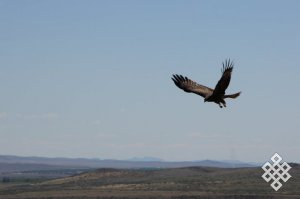 In Almaty, presentation of documentary film of famous Kazakhstan director Rustem Abdrashov "In Search of Tengri" (Tengir Zharylkasyn) took place. Why this journey of a group of scientists, ethnographers, artists and journalists is based on Genghis Khan's route, the origin of the idea, and what happened as a result - journalists present at the press-showing received the answers to these questions during 2.5 hours of the film.
In Almaty, presentation of documentary film of famous Kazakhstan director Rustem Abdrashov "In Search of Tengri" (Tengir Zharylkasyn) took place. Why this journey of a group of scientists, ethnographers, artists and journalists is based on Genghis Khan's route, the origin of the idea, and what happened as a result - journalists present at the press-showing received the answers to these questions during 2.5 hours of the film.
The main sponsor of the expedition since the planning stage in June 2011 is the media firm "Alash Media Group".
Information support was provided by channel STV, Seventh Channel, radio station TengriFM, and newspaper "Alash Ainasy". A journalist from Tengrinews.kz joined the scientific-artistic collective of turkologist Napil Bazylkhan, turkologist-arabologist Robert Ermes; artist-restorer Krym Altynbekov, film director and cinematographer Sabit Kurmanbekov, musician-ethnographer, kobyz-player Erlan Sabitov, dombra player Abulkhair Abdrash; rock-singer Asem, photographer Rustem Rakhimjan and others. From that moment, light was thrown on every step of the expedition for 15 days of travel.
Half a year was necessary for preparation for the expedition, and the same amount went into the montage of the film material. In the first scene of the film, wide Kazakh steppe opens up, not to the traditional sounds of the dombra, but to director Abdrashov's jaw harp playing. The music is in harmony with the picture, and prepares the spectator for the absorbing pilgrimage into the era of ancestors. "Now, in this place there is a whole state of once nomadic peole - independent Kazakhstan. 20 years ago, it was barely possible to dream about such a journey, but now it is reality," - says the director of CentauRus studio.
19 people took off on this time travel trip without any concrete scenario. As the director later expressed it, the road dictated the script. Organizers of the project planned to travel for 4,000 km on the route Almaty - Gorniy Altai(Russia) - Bayan-Olgii (Mongolia). However, instead they traveled 6,000 km working night and day, having only a couple of hours left for sleep. The director admits that on the way to Mongolia at time unexplainable things happened. For example, on the way through the Gobi desert the expedition members got lost. The history of the four-hour search might not have shown up in the film at all: the cassette mystically disappeared during the montage in Almaty. True, later it was found and the necessary "pieces" were inserted. A strange thing happened when a journalist was photographing exhibits in a museum where monuments of Turkic runic writing made of blue marble are kept to protect them from the winds and precipitation of the steppe. The camera simply got stuck at the shots, and did not document anything.
Among all the twist and turns that happened during the trip, most of all the expedition members were shaken by deep sounds of playing kobyz in Mongolian steppe by the memorial complex of Turk military leader Kultegin. The Kazakh instrument played with such heartbreaking feeling, that the team stayed by the stele of the Ancient Turk general, and then could not leave right away. They returned three times into Kultegin's energetic field, until finally they killed a sheep as a sacrifice to the local protector spirits.
The expedition members visited the birthplace of Soviet writer Vasiliy Shukshin, presented the film "Skies of my childhood" in Russia and Mongolia, formed a new rock-group, and gave concerts. The Kazakhs observed the birthday of Astana (Kazakhstan capital) in Mongolia, happened onto the Naadam national holiday, witnessed the largest-scale horse races and traditional wrestling "bekh" in Bayan-Olgii, visited the ancient capital Karakorum and Erdeni monastery, visited Buddhist temples and local museums.
As the route led along stony roads, the vehicles traveled at the speed of 40 km/hour, and delays were caused by punctured tires. On the way to Olgii Onur tourist base, the road trip members wandered around in a fog searching for a place to spend the night.
But the main part was that people of various ages and professions, putting aside their daily work, learned about their old and new history which literally lay under their feet. In that way, the expedition members visited memorial complexes of the great general Kultegin, as well as Bilge-Kagan, Tonyukuk, untouched tombs of khans and balbal stones.
All the journal notes went into the foundation of the documentary. A film of five parts of 39 minutes each was the result. "In Search of Tengri" film documentary will be shown on January 28 at 18:30 on the STV channel.

